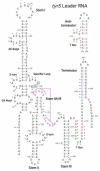The T box mechanism: tRNA as a regulatory molecule
- PMID: 19932103
- PMCID: PMC2794906
- DOI: 10.1016/j.febslet.2009.11.056
The T box mechanism: tRNA as a regulatory molecule
Abstract
The T box mechanism is widely used in Gram-positive bacteria to regulate expression of aminoacyl-tRNA synthetase genes and genes involved in amino acid biosynthesis and uptake. Binding of a specific uncharged tRNA to a riboswitch element in the nascent transcript causes a structural change in the transcript that promotes expression of the downstream coding sequence. In most cases, this occurs by stabilization of an antiterminator element that competes with formation of a terminator helix. Specific tRNA recognition by the nascent transcript results in increased expression of genes important for tRNA aminoacylation in response to decreased pools of charged tRNA.
Figures


Similar articles
-
In vivo and in vitro processing of the Bacillus subtilis transcript coding for glutamyl-tRNA synthetase, serine acetyltransferase, and cysteinyl-tRNA synthetase.RNA. 1999 Feb;5(2):281-9. doi: 10.1017/s1355838299980858. RNA. 1999. PMID: 10024179 Free PMC article.
-
Aminoacyl-tRNA synthetase gene regulation in Bacillus subtilis: induction, repression and growth-rate regulation.Mol Microbiol. 1995 May;16(4):709-18. doi: 10.1111/j.1365-2958.1995.tb02432.x. Mol Microbiol. 1995. PMID: 7476165
-
tRNA determinants for transcription antitermination of the Bacillus subtilis tyrS gene.RNA. 2000 Aug;6(8):1131-41. doi: 10.1017/s1355838200992100. RNA. 2000. PMID: 10943892 Free PMC article.
-
Aminoacyl-tRNA synthetase genes of Bacillus subtilis: organization and regulation.Biochem Cell Biol. 1999;77(4):343-7. Biochem Cell Biol. 1999. PMID: 10546897 Review.
-
An evolving tale of two interacting RNAs-themes and variations of the T-box riboswitch mechanism.IUBMB Life. 2019 Aug;71(8):1167-1180. doi: 10.1002/iub.2098. Epub 2019 Jun 17. IUBMB Life. 2019. PMID: 31206978 Free PMC article. Review.
Cited by
-
Growth-Optimized Aminoacyl-tRNA Synthetase Levels Prevent Maximal tRNA Charging.Cell Syst. 2020 Aug 26;11(2):121-130.e6. doi: 10.1016/j.cels.2020.07.005. Epub 2020 Jul 28. Cell Syst. 2020. PMID: 32726597 Free PMC article.
-
Structural Insights into RNA Dimerization: Motifs, Interfaces and Functions.Molecules. 2020 Jun 23;25(12):2881. doi: 10.3390/molecules25122881. Molecules. 2020. PMID: 32585844 Free PMC article. Review.
-
Cartography of methicillin-resistant S. aureus transcripts: detection, orientation and temporal expression during growth phase and stress conditions.PLoS One. 2010 May 20;5(5):e10725. doi: 10.1371/journal.pone.0010725. PLoS One. 2010. PMID: 20505759 Free PMC article.
-
Sequence, structure, and stacking: specifics of tRNA anchoring to the T box riboswitch.RNA Biol. 2013 Dec;10(12):1761-4. doi: 10.4161/rna.26996. Epub 2013 Nov 4. RNA Biol. 2013. PMID: 24356646 Free PMC article. Review.
-
Riboswitches and Translation Control.Cold Spring Harb Perspect Biol. 2018 Nov 1;10(11):a032797. doi: 10.1101/cshperspect.a032797. Cold Spring Harb Perspect Biol. 2018. PMID: 29844057 Free PMC article. Review.
References
-
- Henkin TM. Regulation of aminoacyl-tRNA synthetase gene expression in bacteria. In: Ibba M, Francklyn C, Cusack S, editors. The aminoacyl-tRNA synthetases. Landes Bioscience; 2004. pp. 309–13.
-
- Henkin TM, Grundy FJ. Sensing metabolic signals with nascent RNA transcripts: The T box and S box riboswitches as paradigms. Cold Spring Harbor Symp. Quant. Biol. 2006;71:231–7. - PubMed
-
- Henkin TM, Yanofsky C. Regulation by transcription attenuation in bacteria: how RNA provides instructions for transcription termination/antitermination decisions. BioEssays. 2002;24:700–7. - PubMed
Publication types
MeSH terms
Substances
Grants and funding
LinkOut - more resources
Full Text Sources
Other Literature Sources

